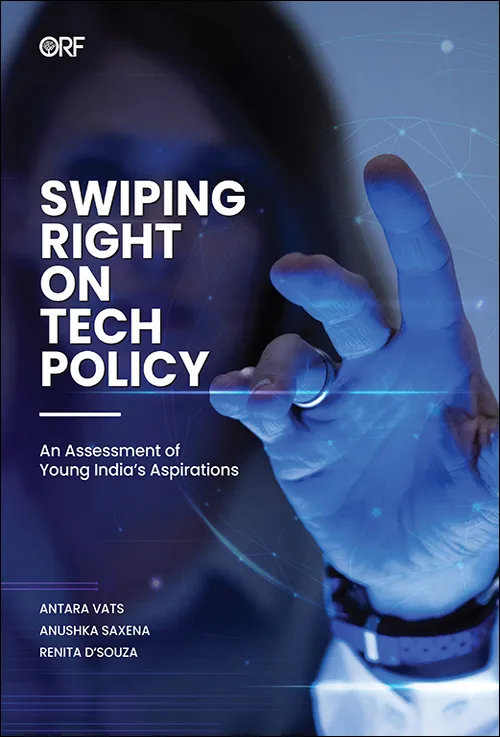What India’s Youth Want from Policy Deliberations on Technology: Key Takeaways
- India’s youth have a strong interest in safeguarding their individual privacy. More than eight of every 10 respondents (88 percent) believe that they should be able to determine how their data is shared and used by the government and social media intermediaries.
- More than seven of every 10 respondents (79 percent) support the right to be forgotten through the mandatory erasure, on a user’s request, of their personal information that is being collected and processed by private companies.
- India’s youth support data localisation. About 70 percent of the respondents agree with the proposal that foreign enterprises should store and process data within data centres in India.
- India’s youth believe that the government must promote domestic technology and enterprises. Eighty-three percent of the respondents support official policies that would create a protectionist environment for India’s technology industry. Meanwhile, 58 percent of the respondents say they rarely or never use Indian alternatives to foreign social media platforms.
- Respondents support government investments in mobile towers (93 percent), uninterrupted supply of critical mineral resources (88 percent), development of indigenous computer or mobile chips (88 percent), open data regimes for enabling AI innovation (88 percent), and development of indigenous social media platform alternatives or encrypted messaging platforms (88 percent).
- A majority of the respondents (84 percent) support more severe penalties for foreign companies than for Indian companies for privacy-related offences, even if both have committed similar infractions. More than 86 percent of the respondents agree that the government should impose fines on social media intermediaries that are misused to spread rumours that could potentially challenge the credibility of users or pose a threat to their jobs.
- India’s youth are largely comfortable sharing their personal data to support government schemes such as providing rations or cash to the poor (82 percent) and for reducing road accidents (79 percent). There is less support for sharing data to assist the Indian government’s anti-terrorism efforts (59 percent). Over 66 percent of respondents are uncomfortable with the proposal of sharing their biometric data in exchange for monetary compensation.
- Three-fourths of the respondents (77 percent) agree with the idea that the government would prioritise public safety and national security over an individual’s right to privacy.
- Eight of every 10 respondents (80 percent) support the development of offensive cyber capabilities as part of India’s National Cybersecurity Policy. They also support India becoming a part of international coalitions to deter countries from interfering in another country’s elections (79 percent of respondents). Eighty-eight percent agree that international coalitions should impose punitive measures on countries that allow hacker groups to operate from within their territories.
- A majority of India’s youth regard the values of individual privacy, national sovereignty and security, and economic well-being, as being of highest importance.
Introduction
In the past several years, a multitude of technological advancements have become more ubiquitous in people's daily lives. Yet these technologies are not only driving growth but provoking anxieties as well. Since early 2020, the COVID-19 pandemic has highlighted the role of technological connectivity in making economies function, improving socio-economic capabilities, and closing the gender gap in accessing services. At the same time, concerns are growing about issues such as state-sponsored cyberattacks, digital surveillance by foreign entities, and violations of user privacy. Indeed, the fast-digitalising world is expected to become even more complex, and the burden will be borne largely by the younger generations.
India, with over 624 million<1> internet users in January 2021, is the second largest and fastest<2> growing online market globally, ranked only behind China. India had around 448 million social media users in January 2020 and registered an increase of 78 million between 2020 and 2021. The number of internet users in the country is expected to reach 900 million by 2025. At present, the majority of internet users in India are between 20 and 29 years old, and use the Internet to access Edtech and social media platforms.<3> India is also home to one of the youngest populations in the world, with an average age of 29 years (See Figure 1). Among other factors, the youth’s engagement with technological advancements will play a huge role in facilitating India’s economic growth in the coming years.<4>
Figure 1. India’s Demographic Dividend (2022)
 Source: United Nations Population Fund
Source: United Nations Population Fund
Data is the foundation on which digital economies are built. In policy discourses, values of individual dignity and liberty,<5> national asset,<6> and economic resource<7> are assigned to data. These competing characterisations of data based on values have often muddled policy proposals for regulation. In this report, the authors explore how India’s youth understand the role of technology in their lives and relate to it. The analysis primarily uses data collected from a survey that investigates their support for proposals on the regulation of data and technology across three parameters: individual privacy, national sovereignty and security, and economic well-being. The authors also use secondary sources to corroborate the survey findings and develop a comprehensive context for the reader.
This report has a threefold aim:
- To measure the awareness of India’s youth on the approaches adopted by consumers, commercial entities, and states to enhance cybersecurity and individual privacy.
- To identify the concerns of India’s youth around the domestic and international approaches adopted for the regulation of technology vis-à-vis individual privacy, economic well-being, and national sovereignty and security.
- To gauge the opinions of India’s youth on future policy options as the country seeks to level concerns around individual privacy, economic well-being, and national sovereignty and security.
Context and Rationale of the Survey
Perception surveys around technology policy in India have mostly been centred around gauging the views of enterprises.<8> For example, the National Science and Technology Management Information System<9> under the Department of Science and Technology conducts periodic national surveys to collect data on resources dedicated to research and development (R&D) in science and technology (S&T). The data is collected from 6,000 tech R&D organisations including multinational corporations, non-government organisations, educational institutions, and private and public sector enterprises across India. The data informs India’s score on national R&D indicators for assessment and policy formulation.
Meanwhile, McKinsey Global Institute in March 2019, surveyed more than 600 private enterprises and conducted interviews with stakeholders from the government and civil society. The survey was part of an ongoing series that tracks the impact of digital technologies on regions across the world, including India,<10> the United States, and Europe. In the context of India, the study aimed to map how digital capabilities could assist in increasing productivity and reshaping business value chains, and enhance the economic prosperity of Indian citizens. The focus was on four sectors that could benefit immensely from digitisation: agriculture, healthcare, logistics, and retail.
While enterprises provide critical insights into the development side of technology, citizens are better placed to provide views on the impacts of these technologies on society. Yet, surveys that measure technology policy awareness of Indian citizens have been few and far between. One of the first detailed investigations on the Indian youth’s awareness of privacy issues was conducted in late 2012 by researchers from the Indraprastha Institute of Information Technology in Delhi . It had 10,427 respondents and also included focus group discussions and expert interviews.<11>
As the adoption of technological innovations soared in recent years, especially during the first waves of the COVID-19 pandemic, there has been an increase in citizen-centric surveys that examine the impacts of these technological advancements. These include initiatives by the Washington Post and the Schar School of Policy and Government at George Mason University in November 2021;<12> the Pew Research Center survey, “The Future of Digital Spaces and Their Roles in Democracy”; and Elon University’s ‘Imagining the Internet Centre’, also in November 2021.<13> The European Commission released its Special Eurobarometer Report - Digital Rights and Principles<14> in December 2021, which was based on a survey that gauged the views of EU citizens on the role of digital tools in their lives, their perception about online rights, and the proposed European common principles on digitalisation. In February 2021, Ernst and Young (EY), under its Connected Citizens Programme, conducted a global survey<15> to assess people’s views on how technology is shaping their lives.
In India, the Office of Principal Scientific Advisor of the Prime Minister and the IIT Madras Alumni Association conducted a survey in November-December 2020.<16> It covered 1,564 respondents, and sought to gather insights on the attitudes of citizens towards the role played by S&T and emerging technologies in the pandemic-era ‘new normal’ of work and economic opportunities. Meanwhile, CUTS International, a think tank based in India conducted a survey<17> in March 2021 to measure consumers' understanding of policies on encryption.
While these surveys may have provided answers to the questions outlined in their research design, they failed to accord focus on India’s youth—the country’s so-called “demographic dividend”. This is a gap that needs to be filled, as it is the youth who will have to live with the greatest impacts of the policies emanating from these discussions.
ORF’s technology policy survey, Swiping Right on Tech Policy, was administered from October to November 2021 to 2,002 Indians aged 18 to 35. The aim was to bridge the gap in youth’s voices in deliberations around technology policy, especially at the intersection of individual privacy, national sovereignty and security, and economic well-being. Discussions on individual privacy cannot be done in isolation from the evolving political and economic environment wherein data-sharing is central to realising values such as national sovereignty and economic well-being. Analysts have often referred to the so-called “digital trilemma”—<18>,<19> between individual privacy, national sovereignty and security, and economic well-being.
This survey report investigates whether India’s youth consider this trilemma. In the context of this survey, the digital trilemma, or the Penrose triangle, translates into individuals knowingly or unknowingly giving more importance to, or favouring two of these concerns while sacrificing the third. The report finds evidence in favour of such a tendency. In the post-pandemic world, there is a need to strive for a policy environment that accords equal importance to all three and reconciles them.
Notes on the Survey
A. Structure of the Questionnaire
ORF, in collaboration with Impetus Research, administered the questionnaire to a sample set of 2,002 individuals scattered across India’s 36 states and union territories (UTs). The questionnaire was divided into four sections: demographic details; awareness of technology-related issues; perceptions on critical questions about technology; and inputs on relevant interventions that could determine future policies by the government and private sector (see Annexure for the questionnaire). The questions in sections two, three, and four belonged to one of three parameters: individual privacy, national sovereignty and security, and economic well-being.<20>
For the purposes of this survey, the term individual privacy<21> refers to the right to keep their personal and sensitive information (including biometrics, and financial and locational data) safe from unauthorised, non-consensual use by business and government entities. The scope of individual privacy as a concept covers practices adopted by individuals to ensure cyber hygiene, and their understanding of consent framework and data localisation.
Security, meanwhile, is required for any community and is primarily a responsibility of the state.<22> Under national sovereignty and security, the survey studies the willingness of an individual to share their data with the government or private sector enterprises to ensure the country’s sovereignty and law enforcement, along with their inclination to support technology protectionism and international collaboration for security purposes. Under economic well-being, the survey evaluates the willingness of individuals to share their data for better delivery of public services and economic gains, along with concerns around existing models of data-sharing.
As noted in the Non-Personal Data Governance Framework (NPDGF)<23> report by the Kris Gopalakrishnan Committee set up by the Ministry of Electronics and Information Technology (MeitY) in 2020, “From an economic lens, data is non-rivalrous, yet excludable, and its use could have both positive and negative externalities.” The value of data is not necessarily accrued by individuals who are generating it or national jurisdictions within which it is generated, but by enterprises who are exercising control over it. In recent years, MeitY and NITI Aayog have shared proposals with citizens as part of public consultations to ensure the value generated from data is distributed among citizens and society.<24> This survey also included questions on novel models of data-sharing.
B. Survey Design
The respondents belonged to the age group of 18 to 35 years. The survey was conducted by telephone—considering the constraints of the COVID-19 pandemic—and covered 2,002 Indian citizens residing in urban districts. The survey employed a stratified population sampling technique to arrive at a representative sample, with “representativeness” being defined in relation to the objectives of the study. Since the sample consisted only of mobile-phone users, it was stratified by telecom circles, resulting in 23 independent strata representing 36 states and UTs. Within each stratum, a random sample was drawn through Random Digit Dialling (RDD).
C. Accessibility and Inclusion
The survey questions were framed in a manner accessible to a wide base of respondents, and care was taken in the use of complex terminology or jargon. Moreover, to ensure the integrity of the survey, the questionnaire was translated into regional languages. The five-point Likert scale<25> was employed in the formulation of the questionnaire. In alignment with other technology policy surveys and to account for the significant gap in digital literacy in India,<26> the questionnaire provided response options such as ‘Refuse to answer’ and ‘Don’t know’. As the survey was completely telephonic, it is characterised by limitations typically associated with such surveys. For example, non-verbal clues from the respondents would not have been captured by the survey data.
D. Methodology for Analysis
The survey aimed to shine a light on the perceptions of India’s youth on issues related to the country’s technology policy. The analysis uses an appropriate combination of descriptive statistics and statistical inference to tease out certain patterns in the respondents’ views. The authors have used the basic tool of ‘percentages’ and ‘proportions’—more specifically, percentage or proportion of responses, that end up being the core statistical entities anchoring the primary statistical investigations that were undertaken.
The authors have aggregated certain responses for purposes of the analysis. For example, the responses of 'always' and 'very often' have been combined into 'often'; the responses of 'very comfortable' and 'somewhat comfortable' have been combined into 'comfortable'; the responses of 'very important' and 'somewhat important' have been combined into 'important'; the responses of 'strongly agree' and 'somewhat agree' have been combined into 'agree'; and the responses of 'strongly support' and 'somewhat support' have been combined into 'support'. Furthermore, the percentage values shown in the pie charts may not add up to an exact 100 percent in all instances as the percentages are rounded off decimal numbers. Nevertheless, they will always be close to 100 percent.
This study gauges the predominant mood of those surveyed, while providing important insights on any remarkable deviations across the responses. These variances could belong to different categories of important demographic variables such as age, gender, geography, education, and occupation. To discern whether the difference in the percentage of responses across categories of demographic factors are statistically significant, the authors employ the test of significance for different proportions in large samples.
The survey set out with the hypothesis that a digital trilemma or a Penrose triangle exists between the values of individual privacy, national sovereignty and security, and economic well-being. The investigation is anchored in the notion of ‘proportion of responses’. However, in one part of this investigation, this proportion is calculated in a different manner to suit the requirements of the analysis. (The complete methodology is discussed in detail in a latter section of the report.)
The variables are defined as follows:
- Age: Gen-Z, which covers those born between 1995 and 2004; and Millennials, or those born between 1987 and 1994
- Gender: Males and Females
- Education: Those who pursued education after school, including those who have completed or are enrolled for their diplomas, undergraduate and postgraduate degrees; and those who studied till class XII or below.
- Employment: Employed and Unemployed.
- Geographical zones: North, South, East, and West.<27>
Read the entire report here.
About the Authors
Antara Vats is a Junior Fellow at ORF, Delhi.
Anushka Saxena is a Research Intern at ORF, Delhi.
Renita D’Souza is a Fellow at ORF, Mumbai.
<1> Simon Kemp, Digital 2021: India. Data Reportal, 2021.
<2> KANTAR and IAMAI, Internet Adoption in India - ICUBE 2020, 2021.
<3> Sandhya Keelery, Internet Usage in India - statistics & facts, Statista.
<4> Ministry of External Affairs, “One of The Youngest Populations in the World – India’s Most Valuable Asset,” Economic Diplomacy Division, June 13, 2021.
<5> V. Shivshankar, “Privacy and Essential Aspects of Human Dignity, says Supreme Court in Historic Ruling,” The Wire, August 24, 2017.
<6> Simon Hansford, “Data must be treated as a national asset,” Public Technology, January 10, 2020.
<7> The Indian Express, “Data is an economic resource. Gopalakrishnan committee report shows how its value can be shared, governed,” July 27, 2020.
<8> Nirvikar Singh, “Information Technology and its Role in India’s Economic Development: A Review”, UCSC, (2014).
<9> Department of Science and Technology, "National Science and Technology Management Information System'', Ministry of Science and Technology.
<10> Noshir Kaka et al., Digital India - Technology to Transform a Connected Nation, Mckinsey Global Institute, 2019.
<11> Ponnurangam Kumaraguru and Niharika Sachdeva, “Privacy in India: Attitudes and Awareness V 2.0”, Indraprastha Institute of Information Technology, Delhi, (2012).
<12> The Washington Post and Schar School of Policy and Government, “Washington Post-Schar Poll,” 2021.
<13> Janna Anderson and Lee Rainie, The Future of Digital Spaces and Their Role in Democracy, Pew Research Centre, 2021.
<14> European Commission, Digital Rights and Principles, 2021.
<15> Arnauld Bertrand and Julie McQueen, How can digital government connect citizens without leaving the disconnected behind?, Ernst and Young, 2021.
<16> Office of the Principal Scientific Adviser to the Government of India and IIT Madras Alumni Association. Science and Technology in the New Normal in India - A Public Attitude Study, 2021.
<17> Amol Kulkarni, Sidharth Narayan, and Setu Bandh Upadhyay, Understanding Consumers Perspective on Encryption in India, CUTS International, 2021.
<18> Samir Saran, “Navigating the Digital ‘Trilemma”, Observer Research Foundation, (2016).
<19> Zsófia Hajnal, “The Impossible Trinity of Security, Freedom and Privacy”, Securitologia, (2017).
<20> The categorisation of questions with the three parameters is based on the authors’ assessment of the level of relevance of each question vis-a-vis each parameter. For example, the question about data localisation could be assessed on all the three parameters. However, in the authors’ judgement, it is most relevant to the parameter of ‘individual privacy’ and has been categorised as such.
<21> IAPP, “What is Privacy?”.
<22> David Baldwin, “The concept of security”. Review of International Studies. Vol. 23, (1997).
<23> MeiTy, Report by the Committee of Experts on Non-Personal Data Governance Framework, July 2020; https://static.mygov.in/rest/s3fs-public/mygov_159453381955063671.pdf; December 2020.
<24> NITI Aayog, Government of India, Data Empowerment and Protection Architecture, (August 2020).
<25> Likert scale is a psychometric scale used in questionnaires for scaling responses.
<26> Sumeysh Srivastava, “International Literacy Day: Bridging India’s Digital Divide”, Bloomberg, September 8, 2020.
<27> In this study, South includes Andhra Pradesh, Telangana, Karnataka, Kerala, Tamil Nadu, Lakshadweep and Chennai; North consists of Delhi, Western Uttar Pradesh, Eastern Uttar Pradesh, Haryana, Himachal Pradesh, Jammu and Kashmir, Punjab, Rajasthan, Bihar and Jharkhand, Madhya Pradesh and Chattisgarh; West is composed of Gujarat, Maharashtra, Goa and Mumbai; and East comprises Assam, Kolkata, North East, West Bengal and Odisha. Despite being cities, Mumbai, Kolkata and Chennai have been considered separately from the states they belong to, given their distinct importance in the telecom circle.
The views expressed above belong to the author(s). ORF research and analyses now available on Telegram! Click here to access our curated content — blogs, longforms and interviews.

 PDF Download
PDF Download




 PREV
PREV



.png)
.png)